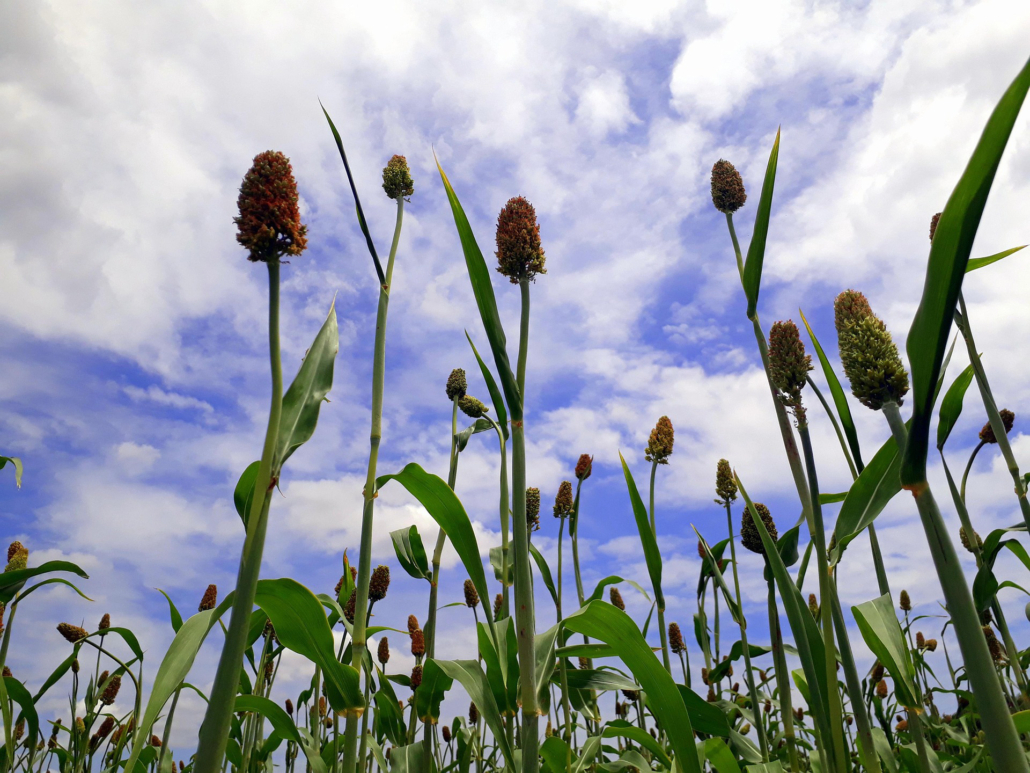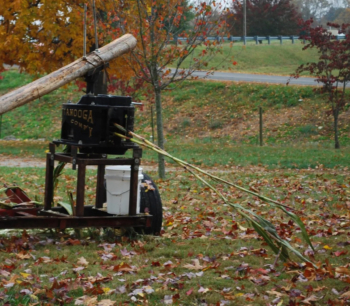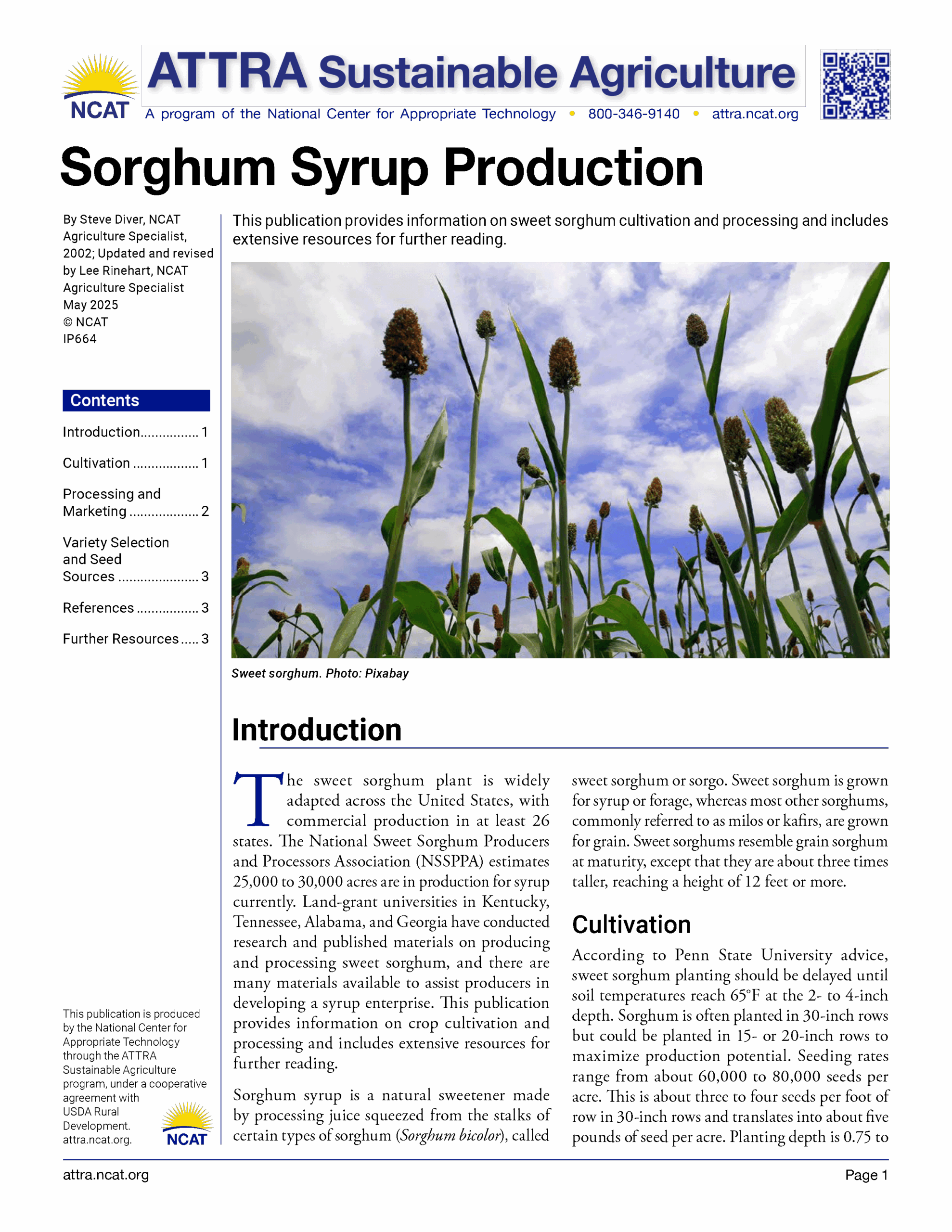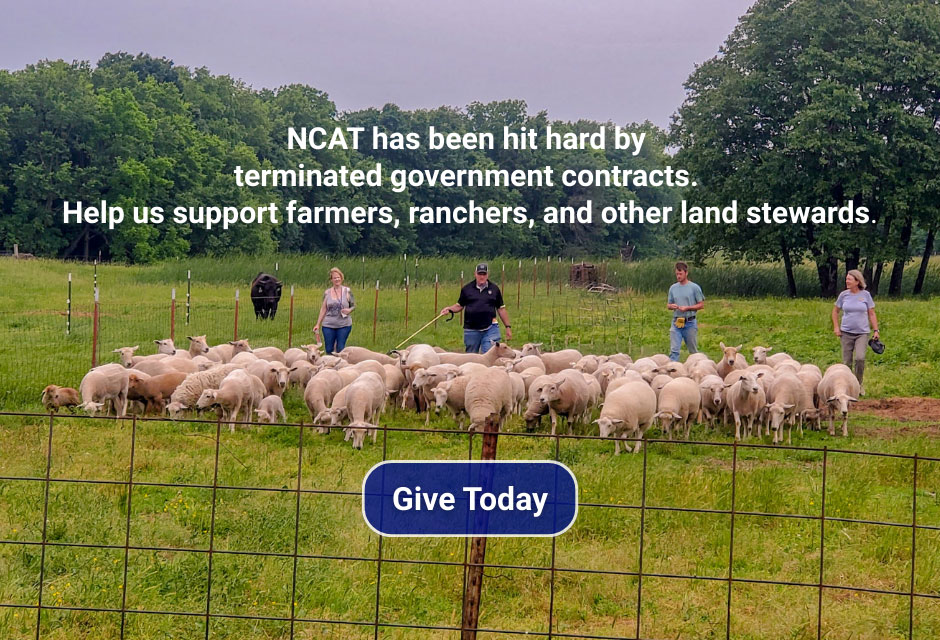Sorghum Syrup Production
By Steve Diver, NCAT Agriculture Specialist, 2002
Updated and revised by Lee Rinehart, NCAT Agriculture Specialist, May 2025

Sweet sorghum. Photo: Pixabay
Abstract
This publication provides information on sweet sorghum cultivation and processing and includes extensive resources for further reading.
Contents
Introduction
Cultivation
Processing and Marketing
Variety Selection and Seed Sources
References
Further Resources
Introduction
The sweet sorghum plant is widely adapted across the United States, with commercial production in at least 26 states. The National Sweet Sorghum Producers and Processors Association (NSSPPA) estimates 25,000 to 30,000 acres are in production for syrup currently. Land-grant universities in Kentucky, Tennessee, Alabama, and Georgia have conducted research and published materials on producing and processing sweet sorghum, and there are many materials available to assist producers in developing a syrup enterprise. This publication provides information on crop cultivation and processing and includes extensive resources for further reading.
Sorghum syrup is a natural sweetener made by processing juice squeezed from the stalks of certain types of sorghum (Sorghum bicolor), called sweet sorghum or sorgo. Sweet sorghum is grown for syrup or forage, whereas most other sorghums, commonly referred to as milos or kafirs, are grown for grain. Sweet sorghums resemble grain sorghum at maturity, except that they are about three times taller, reaching a height of 12 feet or more.
Cultivation
According to Penn State University advice, sweet sorghum planting should be delayed until soil temperatures reach 65°F at the 2- to 4-inch depth. Sorghum is often planted in 30-inch rows but could be planted in 15- or 20-inch rows to maximize production potential. Seeding rates range from about 60,000 to 80,000 seeds per acre. This is about three to four seeds per foot of row in 30-inch rows and translates into about five pounds of seed per acre. Planting depth is 0.75 to 1.25 inches. If broadcasting seed, the seeding rate should be 10 to 15 pounds per acre. Harvesting occurs near the soft dough stage, often 120 days or so after planting. Producers can use a Brix meter to assess the sugar content at harvest (Roth, 2022; Undersander et al., 1990). For more information on planting, growing, and harvesting, see the state-specific educational materials listed in the Further Resources section.
Processing and Marketing

Processing sorghum syrup. Photo: SNNPPA
Specialized milling equipment is necessary to extract the juice from sweet sorghum stalks, and evaporative pans with heating units are an effective way to steam off excess water, leaving syrup. It takes about eight gallons of juice to make one gallon of syrup.
The correct label for sorghum syrup is “sorghum syrup” or “pure sorghum.” Molasses, unsulphured molasses, cane molasses, and cane syrup are byproducts of sugarcane processing and sugar crystallization. “Sorghum molasses” is a blend of sorghum syrup and sugarcane molasses.
Sweet sorghum is ideally suited to the small, diversified farm. The seed heads (which are cut off prior to processing) can be fed to chickens. The grain, leaves, and stalks of sweet sorghum can be fed to ruminant livestock. Bagasse, the organic waste from sorghum syrup processing, can also be fed to livestock or composted and returned to the fields.
Traditionally, the use of herbicides, insecticides, and fungicides is minimal or eliminated altogether in the production of sorghum syrup. Farmers raising sweet sorghum will need to use good cultural practices, such as crop rotations, cover crops, and timely cultivation, to avoid weed problems.
According to the University of Kentucky Cooperative Extension, “At a price of $15 per gallon, a yield of about 70 gallons per acre will be needed to break even for all variable and fixed costs if canes are not stripped before they are cut. The average yield for sweet sorghum is 175 gallons per acre; however, yields can go as high as 200 to 300 gallons per acre. If producers can obtain prices of $20 to $25 per gallon of sorghum syrup, net returns of more than $2,500 per acre are possible at yield levels of 175 gallons and above” (Bitzer and Pfeiffer, 2013).
Yields of 200 to 300 gallons of syrup per acre are possible, though 120 to 130 gallons is an average yield. Wholesale prices for sorghum syrup run about $12 to $15 per gallon. In a crop budget analysis done by the Kerr Center for Sustainable Agriculture in Oklahoma, a sorghum enterprise realized profitable returns to land and management at a yield of 112 gallons per acre, selling for $18 per gallon (this was in the 1990s). Many small-scale growers aim for $30 per gallon. Niche marketing, smaller jars, and fancy labeling are strategies that can help achieve this goal.

Small scale mill. Photo: NSSPPA
In the past, sorghum mills were a common feature of southern agriculture. Farmers could process their crop at local mills, often on a share arrangement with the mill owner. One of the biggest challenges facing new producers today is the lack of milling equipment. Most growers rely on used equipment manufactured decades ago for the sorghum syrup and sugarcane industries.
For pressing at small scale, it is possible to use a hand-cranked 2- or 3-pin laundry roller bolted to a table. Larger-scale operations will require a mill powered by a tractor. Grain Maker (grainmaker.com) has developed a small, hand-operated sorghum press that sells for about $4,000 new.
Stainless steel, galvanized steel, or copper pan evaporators are the other major equipment items associated with sorghum syrup production. Pan evaporators are usually custom-manufactured, and are available through suppliers to the sorghum syrup, sugarcane, and maple sugar industries. A refractometer, thermometer, fuel burner, enzymes, containers, and labels are other supplies needed to process and market sorghum syrup.
For processing commercial sweet sorghum, clean facilities are important because the product is sold as a food item to the public. Some states require a food processor permit, and others may want to inspect processing and packing areas.
Variety Selection and Seed Sources
Variety selection is an important consideration and is somewhat region-specific according to climate and soil type. Qualities to evaluate when selecting a variety include the following:
- days to maturity
- growth habits matched to harvest equipment
- stalk size
- cold tolerance
The Mississippi Agricultural and Forestry Experiment Station (MAFES) Foundation Seed Stocks supplies certified seed for sweet sorghum varieties—Dale, Theis, M81-E, Top 76-6—adapted to the Mid-South region. See the Further Resources section for sources of seed.
References
Bitzer, Morris, and Todd Pfeiffer. 2013. Sweet Sorghum [PDF}. University of Kentucky.
Roth, Greg. 2022. Sweet Sorghum Production Basics. Penn State University. extension.psu.edu/sweet-sorghum-production-basics
Undersander, D.J., W.E. Lueschen, L.H. Smith, A.R. Kaminski, J.D. Doll, K.A. Kelling, and E.S. Oplinge. 1990. Sorghum Syrup. University of Wisconsin-Madison.
Further Resources
Production Guides
Sweet Sorghum Production and Processing. 2025. By George Kuepper, Kerr Center for Sustainable Agriculture.
The updated third edition is available as a downloadable PDF for $10.00. A printed version is available for $18.00. This comprehensive manual is a practical handbook on everything a farmer needs to know about sorghum growing and processing, including information on pest control. It is based on the Kerr Center’s experience with sorghum production and includes photographs of equipment and processing methods.
Farm Made: A Guide to On-Farm Processing for Organic Producers [PDF]. 2009. By George Kuepper, Holly Born, and Anne Fanatico, Kerr Center for Sustainable Agriculture.
Free download that includes information on sorghum syrup.
Production of Sweet Sorghum for Syrup in Kentucky [PDF]. 1994. By Morris J. Bitzer. University of Kentucky.
Processing Sweet Sorghum for Syrup [PDF]. 2000. By Morris J. Bitzer and Joe D. Fox. University of Kentucky, AGR-123.
Sweet Sorghum Production Guide[PDF]. 2014. By H. P. Viator, K. J. Han, D. L. Harrell, D.F. Day, M. Salassi, and M.W. Alison. LSU Ag Center.
Syrup Sorghums for Texas. 1995. By Stephen Livingston and Cloyce G. Coffman. Texas A&M AgriLife.
Seed Sources
Varieties: Dale, 120 days; Della, 114 days; Honey Drip, 105 days; M81E, 135 days; Simon, 100 days; Sugar Drip, 105 days; Umbrella, 112 days
Southern Exposure Seed Exchange
Varieties: Black Amber Cane, Coral, Dale, Della, Iowa Sweet, Korjaj, Mennonite, Sugar Drip
Varieties: Mennonite, Honey Drip
Varieties: Sugar Drip,Coral, Dale, White African, Della
Thresh Seed Co. Heirloom Garden Seeds
Varieties: Mennonite, Dale, Sugar Drip, Kansas Orange, Black Amber, Sumac, Texas Seeded Ribbon (Gooseneck)
Variety: Williams
Other Resources
National Sweet Sorghum Producers and Processors Association (NSSPPA)
NSSPPA holds a meeting on the first weekend of March each year. The meeting location rotates between Bowling Green, Kentucky, and Nashville, Tennessee. The association publishes a newsletter to exchange information among producers, as well as a directory. One of the best ways to learn how to make sorghum syrup is by first-hand exposure. NSSPPA can provide referrals to sweet sorghum farmers in your region, syrup-making festivals, and related events.
Farmers’ Bulletins and Agriculture Handbooks, USDA
Production bulletins proceeding from the turn of the century through the 1970s. Though dated, they still provide an excellent summary of sorghum syrup production, including varieties, cultivation, harvesting, and processing. In addition, the photos and illustrations provide historical glimpses into farm equipment and syrup-making procedures. USDA publications are also located in Land-grant University libraries, and photocopies can often be obtained through Inter-Library Loan. Of special interest are the five historic USDA and Agriculture Experiment Station bulletins listed below that are available as full-text online documents:
- Sorgo-sirup Manufacture. 1924. By A. Hugh Bryan.
- Farm Production of Sorgo Sirup. 1938. By C.F. Walton.
- Sorgo for Sirup Production: Culture, harvesting, and handling. 1942. By Horace Cowgill.
- Culture of Sorgo for Sirup Production. 1957. By I.E. Stokes.
- Culture of Sweet Sorghum for Sirup Production. 1973. By K.C. Freeman.
Sorghum Syrup Production
By Steve Diver, NCAT Agricultural Specialist, 2002
Updated and revised by Lee Rinehart, NCAT Agriculture Specialists
May 2025
© NCAT
IP664
Version 050125
This publication is produced by the National Center for Appropriate Technology through the ATTRA Sustainable Agriculture program, under a cooperative agreement with USDA Rural Development. ATTRA.NCAT.ORG.


